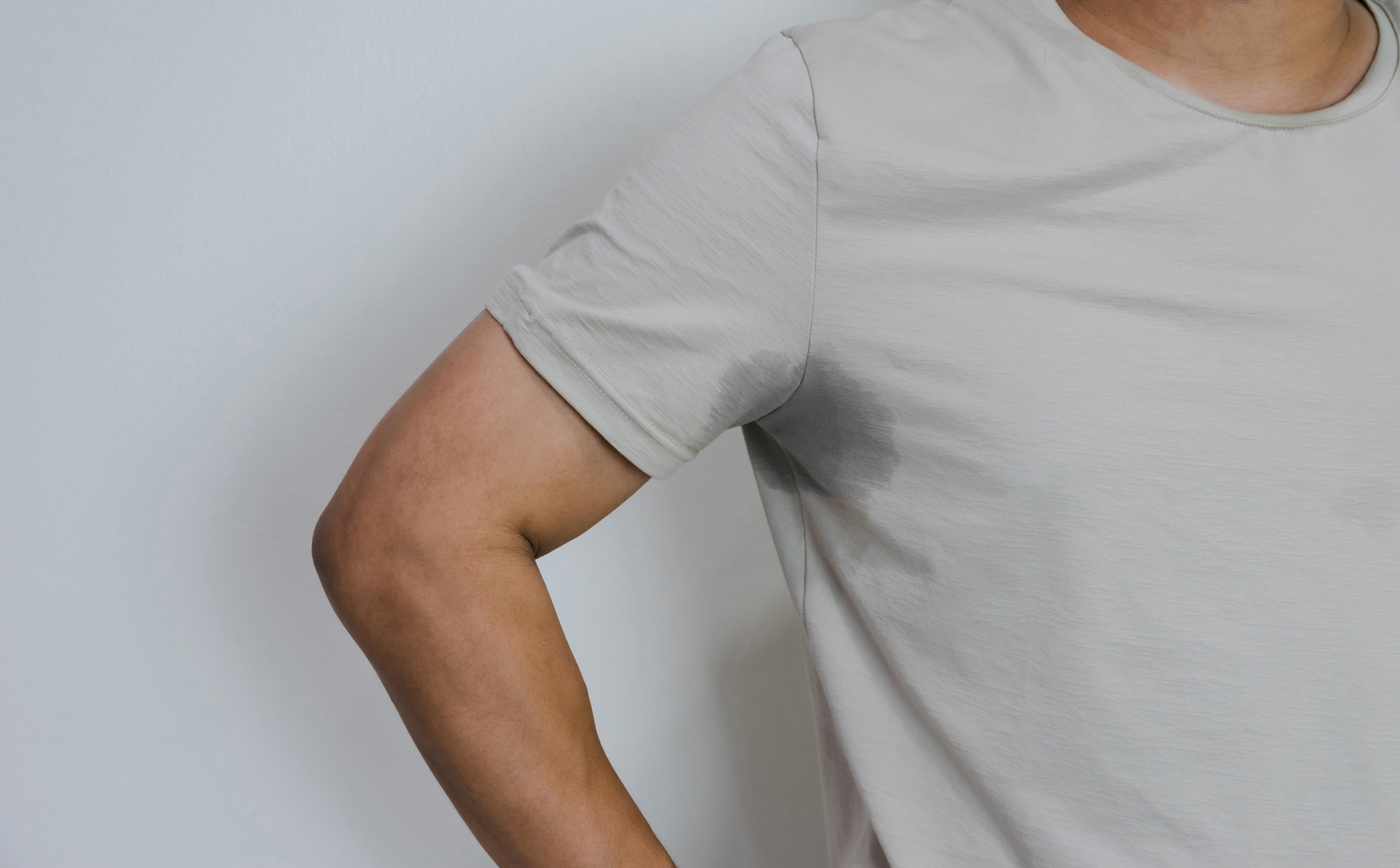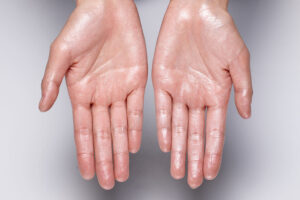Table of Contents
Axillary hyperhidrosis is excessive sweating of the armpits.
It’s uncomfortable, frustrating, demoralizing, and can profoundly affect the quality of life. It’s not always easy to say how much excess sweating is “too much” – it’s different from patient to patient, but there are a few signs you should watch for that may mean you could use some advice from a doctor.
4 Signs It’s Time to See a Doctor About Your Sweaty Armpits
1. Nothing effectively stops armpit sweating
2. You frequently sweat through your shirts
3. You constantly worry about armpit sweat
4. Your quality of life is suffering due to unwanted underarm sweat
To an outside observer, sweaty armpits may seem like no big deal – just a cosmetic inconvenience with no serious side effects.
But axillary hyperhidrosis sufferers know their sweat can wreck everything from first dates to major work presentations.
In fact, from the pit stains to the stench and embarrassment, sweaty underarms can take over your life unless you take control of them.
But you’re not alone and you’re not helpless – you have a number of options to help you get sweaty pits under control and get back to living your best life.
Keep reading for a guide to how to treat your sweaty underarms, along with signs to look for that you might need to talk with your doctor about axillary hyperhidrosis treatment.
What is Axillary Hyperhidrosis?
People who suffer from axillary hyperhidrosis sweat like crazy under their arms – in fact, they can sweat up to five times more than is needed to regulate their body temperature.
The causes of axillary hyperhidrosis aren’t super clear, but we do know that up to 3 percent of the population suffers from hyperhidrosis in some form.
Axillary hyperhidrosis is considered a form of primary hyperhidrosis, which means it is a medical condition in and of itself, and not a side effect of something else, like an underlying medical condition or a medication.
There is some indication that primary axillary hyperhidrosis is genetic, so if you have family members who show symptoms, chances are you may, too.
Axillary hyperhidrosis often begins around adolescence, but some people may not see symptoms until their mid-20s.
4 Signs It’s Time to See a Doctor About Your Sweaty Underarms
Let’s explore in more detail each of the signs that it may be time to see a doctor about treatment for your profuse sweating.
1. Nothing effectively stops armpit sweating
You’ve tried everything you can think of in terms of life hacks and over-the-counter options to stop axillary hyperhidrosis, but nothing seems to be working.
Rather than continuing to go it alone, this may be a good opportunity to consult with your dermatologist about how to take your treatments for axillary hyperhidrosis to the next level.
2. You frequently sweat through your shirts
Whether you’re sweating through undershirts or wringing out your socks during your lunch break, constantly changing into dry, clean clothes can be stressful and exhausting.
If you’re feeling like you need to carry around an extra suitcase full of backup clothes, you may benefit from talking to your doctor about appropriate hyperhidrosis treatment options for you.
3. You constantly worry about armpit sweat
Non-stop worry about sweat stains and armpit odor can be exhausting. If you’re spending crazy amounts of mental and physical energy trying to anticipate and prepare for sweat events, or you shower multiple times a day and constantly shopping for the best deodorant, you may be at a point where you need to ask for some outside help.
4. Your quality of life is suffering due to unwanted underarm sweat
If you’ve reached the point where you’ve either severely limited or stopped your favorite social and professional activities altogether, you may need some advice or assistant from your doctor.
Many people report that they avoid going out in public, socializing with friends, or volunteering for bigger professional projects out of fear of embarrassment related to their axillary hyperhidrosis.
Ultimately, this can lead to reduced self-esteem, lack of confidence, social anxiety, and even loss of concentration or engagement at work. If this describes your situation, it’s a good time to get help from your doctor for how to sweat less.
How Axillary Hyperhidrosis is Diagnosed
Typically, a dermatologist is the best physician to diagnose and treat underarm hyperhidrosis. These skin docs are usually the most familiar with the condition and hyperhidrosis therapy.
Depending on your insurance coverage, you may need to start with your primary care physician, who likely can give you a referral to a dermatologist.
It’s hard for a doctor to actually watch you sweat during an office visit, so your doctor may ask you lots of questions to help get a feel for the full impact of your symptoms. You should be prepared to discuss your medical history, including a list of any medications and supplements you take.
Your doctor will probably also ask about whether anyone else in your family shows similar symptoms, when your symptoms started, whether symptoms are occasional or continuous, and what factors either aggravate or seem to help your symptoms.
It’s pretty gross, but your doctor might also want to look at some of your clothing to measure sweat stains – that can be a good clue to the severity of your armpit hyperhidrosis.
For example, sweat stains of less than five centimeters in diameter may be considered normal, while stains up to 10 centimeters may indicate mild hyperhidrosis. Severe hyperhidrosis can make sweat stains up to 20 centimeters in diameter.
In some cases, your doctor may use gravimetric measurement to assess your situation – this is a more quantitative method that uses pre-weighed filter paper applied to the skin of your underarm area, then weighed so that the rate of sweat production can be calculated.
In addition to this measure, a doctor will take into consideration your description of how your symptoms are affecting your overall quality of life and impairing any daily activities.
An especially good tool for this is the Hyperhidrosis Disease Severity Scale offered by the International Hyperhidrosis Society. Some physicians may also use the Dermatology Quality of Life Index – or some other symptom severity scale.
Your doctor may also order lab tests of blood or urine or other tests to make sure your sweating isn’t caused by an underlying medical condition like diabetes or an overactive thyroid.
In general, once your doctor has decided that axillary hyperhidrosis is your issue, he or she will start you on minimally invasive treatment and go from there.
Axillary Hyperhidrosis Treatment Options
There is no silver-bullet axillary hyperhidrosis cure, but you can treat it with several different over-the-counter options, including topical agents, or clinical procedures for hyperhidrosis relief.
You can also combine various options to find the best effect for your body chemistry. If nothing else works, you do also have surgery options that you can discuss with your doctor.
Antiperspirants
Topical antiperspirants are often the first line of defense for hyperhidrosis relief. They work by forming a temporary “plug” that prevents your underarm sweat glands from releasing sweat.
You can find antiperspirants in a broad range of strengths – even clinical or prescription strength – so you may need to experiment to find the one that works best for you.
In addition, you must use antiperspirants correctly to feel their full benefits. Applying an antiperspirant at night is essential – doing so gives it time to work overnight, when axillary sweat glands are least active, in order to block sweat glands and keep you from pouring sweat the next day.
Typically, a doctor will advise that you start with an over-the-counter antiperspirant to test its efficacy.
If that works for you, then great. If not, you can advance to a clinical-strength antiperspirant – and if that still fails to control excessive underarm sweating, your doctor may prescribe a prescription-strength antiperspirant for you.
Botox
At some point, your physician may recommend botulinum toxin injections (Botox) as treatment of hyperhidrosis. With this method, an experienced medical professional will inject Botox into your underarm area in order to reduce sweating.
This method has proven effective in many cases – in fact, one clinical study showed that 81 percent of patients treated with Botox injections experienced a 50-percent or higher reduction in excessive underarm sweating.
Some patients saw a dramatic reduction in sweating that lasted up to a year.
miraDry
Approved by the FDA in 2011, miraDry is an option that uses thermal energy to destroy sweat glands in the underarm area.
Patient studies suggest miraDry has proven largely successful as a treatment for axillary hyperhidrosis, but it has not yet been approved for use anywhere else on the body.
Clinical trials have shown an average sweat-reduction efficacy rate of 82 percent.
Surgery or Other Medical Procedures
When all other options have been exhausted, some physicians may recommend dermatologic surgery or an outpatient procedure in order to treat your axillary hyperhidrosis.
There are a variety of surgical procedures you could try – they include curettage, liposuction, excision, and laser surgical procedures.
No matter the technique, all of these procedures are designed to surgically remove sweat glands from your underarm area. Each treatment can be performed with a local anesthetic as an outpatient procedure.
In extremely severe cases, your doctor may discuss with you a thoracic sympathectomy, which is a much more complicated and risky procedure.
Dermatologists have seen positive results with many of these techniques, but you should fully discuss with your doctor all of the potential risks and possibly severe adverse events before you decide if any of these procedures make sense for you.
Try Sweatblock
Many people seeking to treat hyperhidrosis have found success by using Sweatblock Clinical Strength Antiperspirant.
While Sweatblock is available in several formulations, its base product is a clinical-strength-antiperspirant formula that is pre-soaked on a soft towelette wipe.
Users simply swipe a Sweatblock wipe under their arms at night before going to sleep, and the trade-secret formula helps keep underarms dry and comfortable for up to seven days after use – and with no skin irritation.
For many users, Sweatblock has proven effective even when many other antiperspirants have come up short.
Understanding Axillary Hyperhidrosis
If not effectively treated, axillary hyperhidrosis can take a serious toll on the quality of life, keeping people from reaching their full potential and, in worst cases, leading to mental health concerns like anxiety and depression.
But the good news is that many treatment options are available to help people manage excessive underarm sweating. You might find exactly what you need with one of the remedies outlined here, or even with a combination of tactics.
Ultimately, the best way to manage your axillary hyperhidrosis is a personal choice, but you should make it after talking with a doctor you trust.
It’s always best to seek the counsel of a qualified medical professional before starting any clinical procedure or surgery for axillary hyperhidrosis.
You might also like...

Why Do My Armpits Sweat So Much? 8 Common Causes for Underarm Sweat
If you find yourself in a constant battle against sweaty armpits, you’re in the right place. Excessive underarm sweating is

How to Stop Armpit Sweat – 12 Ways to Keep Underarms Dry
Have you ever hesitated to hug someone, raise your hand, or cheer on your favorite team solely because you didn’t

Top 10 Best Deodorants For Sweaty Armpits
Do you struggle with sweaty armpits? Has your deodorant let you down when it comes to stopping sweat and providing
















